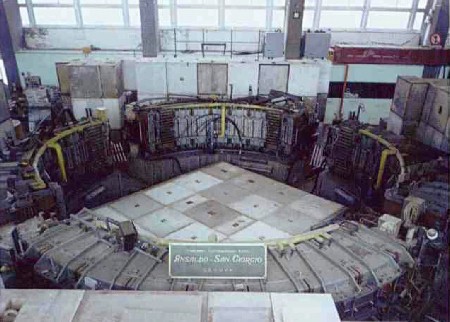

The Electron Synchrotron was the first high energy accelerator realised in Italy. It was approved in 1953 and its construction began in 1957 inside a new laboratory in Frascati, a few kilometers south of Rome. After two years the accelerator was operational, delivering to the experiments photon beams with energy between 0.4 and 1.1 GeV, obtained by hitting the electron beam against a target inside the synchrotron vacuum vessel.
The ~9 m diameter ring consisted in 4 weak focusing bending magnets separated by 4 short straight sections. A 30 mA 12.4 MeV microtron was used as a preinjector. It was capable of delivering 4 msec pulses at 20 Hz, at an intensity of ~5x1010 particles per pulse.
Important results have been obtained with the Electron Synchrotron in the study of pion-nucleon resonances, electron-proton diffusion, neutral pion decays and the properties of the "eta" meson. A satisfactory explanation has been given to the problem of coherent photon production in the bremsstrahlung of electrons in crystals, with the by-product of realising a quasi-monochromatic and polarised photon beam.
The Electron Synchrotron was also the chance to open a new promising field of experimental investigation, now actively pursued all over the world at dedicated facilities: the synchrotron radiation produced by accelerated electrons.
This accelerator has been for the Italian experimental physicists an important tool for gaining the experience required to perform experiments at the large accelerators under construction in the world at that time. The realisation of the machine and of the extracted beams created an italian school of accelerator physics, which opened, after a few years, the new era of colliding beams physics with the realisation of ADA, the first electron-positron storage ring.